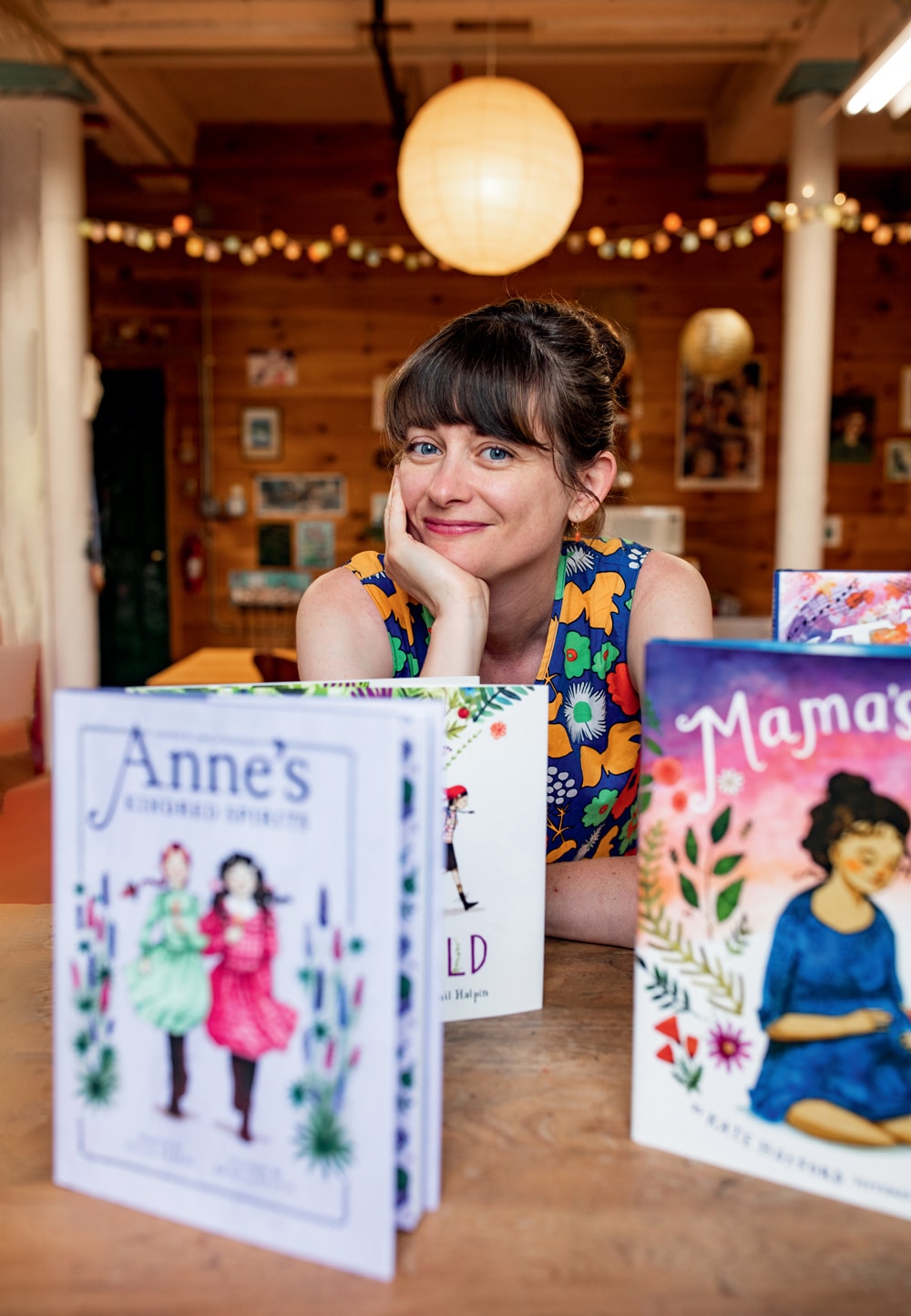A World of Imagination with Illustrator Abigail Halpin | Open Studio
Maine native Abigail Halpin’s vivid illustrations help bring children’s storybooks to life.

Abigail Halpin with some of the books she’s illustrated, including Mama’s Belly and Anne’s Kindred Spirits.
Photo Credit : Jennifer BakosA wild torrent of jungle, splashed with outsize flowers, charges across the pages of Finding Wild, even as slivers of city peer from the background. Abigail Halpin’s bold and brilliant illustrations, inspired by folk art, are barely contained on paper.
Lush colors suffuse Mama’s Belly, too—a reassuring read for little ones about to be joined by a baby sibling. And they entwine with music in her latest, Itzhak: A Boy Who Loved the Violin, written by Tracy Newman, released earlier this year. Each is a reminder that children’s books are a powerful means of hooking young imaginations. Those big covers are simply the doors into another world.

Photo Credit : Jennifer Bakos
Halpin grew up “drawing all the time” in Wells, Maine, where she still lives. Some of the scenes in FindingWild—picking blueberries, jumping off rocks, distant islands rising to the surface like sea turtles—are based on childhood camping trips to Maine state parks. “I think I was more of a visual kid growing up,” Halpin says. “It was easier for me to express emotions, hopes, and dreams visually.”
She mixes mediums effortlessly, to maximum effect—watercolor, gouache, colored pencil—with a dash of digital cleanup. In 2018, Halpin’s series of covers for Taproot, a Maine-based magazine, captured a feeling of rural life so colorfully visceral it makes you want to move right in. Vermont gets its moment, too: Mama’s Belly, with its leafy green abundance, lakes, and mountains, is loosely modeled on an area around Waterbury. Halpin’s New England is irresistible on the page.

Photo Credit : Jennifer Bakos
To be a deeply impactful illustrator, it helps to be a deeply committed reader. “My parents read to us from infancy on,” she says. “As we got older, my mom would read from a chapter book every night, sort of like Netflix for ’80s kids. I’d get to a point where I was so excited: OK … what happens next?! It created such strong visual pictures in my head—I had to put them on paper.”
As a teenager, Halpin was home-schooled, her afternoons filled with drawing and creating. “I had time to suddenly dive into something I loved, and it definitely provided a foundation for me,” she recalls. The beloved children’s book illustrator Tasha Tudor was one of her early influences. So was Gyo Fujikawa: “I was obsessed with her books,” she says. “She was in Japanese internment camps during World War II. Her books are filled with these almost dreamlike little kids.”

Photo Credit : Jennifer Bakos
When Halpin got her first book contract 12 years ago—Maybe Yes, Maybe No, Maybe Maybe, a reissue of Newbery Medal winner Susan Patron’s chapter book about sisters being raised by a single mom—she took a leap of faith and quit her day job as a graphic designer. Sixteen books (and 35 book covers) later, Halpin has also produced two fanciful collections of textiles for Figo Fabrics, a Canadian company that wanted to tap into the contemporary quilting market. “I love sewing, and it had always been a dream to make fabric,” she says. “Fabric is kind of like storytelling in a way—there’s a narrative in there.”
A 15-minute drive from her home in Maine takes Halpin over the border into New Hampshire, to her cheery studio located in a converted brick mill building overlooking the Salmon Falls River in Rollinsford. The building houses a mix of artisans, from photographers and sculptors to a soap maker and a woodworker. “My drafting table is right in front of the window, so I’m looking out on the river, into Maine,” she says. “I get to see the different seasons, the herons—it’s a beautiful view.”

Photo Credit : Jennifer Bakos
It’s where she sat to conjure up the illustrations for Itzhak: A Boy Who Loved the Violin, which recounts the early life of violinist Itzhak Perlman, and her view is about as far from urban 1940s Tel Aviv as you can get. “I definitely did a lot of research in the beginning,” Halpin says. “Even little things like, What would apartments in Tel Aviv have looked like? What were polio treatments like for him? I’ve always really loved that investigative end of it, so I kind of nerded out over the research. It was so interesting.”

Photo Credit : Jennifer Bakos
“At the end of the day, I end up bonding with each of the characters I draw.” Halpin pauses, searching for the right words. “With Itzhak, by the time I was done, and had learned about the odds he’d overcome, the things he’d done, and the joy he brings—that brought joy to making the work. I think you have to fall in love with the characters you illustrate. And when I do—that’s when the art clicks for me.” theodesign.com
Annie Graves
A New Hampshire native, Annie has been a writer and editor for over 25 years, while also composing music and writing young adult novels.
More by Annie Graves

